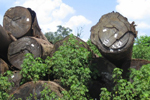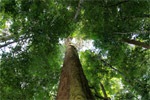- Ecologists may be underestimating the impact of logging in old-growth tropical forests by failing to account for subtleties in how different animal groups respond to the intensity of timber extraction, argues a paper published today in the journal Current Biology.
- The study, led by Zuzana Burivalova of ETH Zurich, is based on a meta-analysis of 48 studies that evaluated the impact of selective logging on mammals, birds, amphibians, and invertebrates in tropical forests.
- “Sustainable forestry” may be far from sustainable for biodiversity at current intensities in some forests.

Some amphibian species, like this Fringe leaf frog (Cruziohyla craspedopus), are particularly affected by heavy logging.
Ecologists may be underestimating the impact of logging in old-growth tropical forests by failing to account for subtleties in how different animal groups respond to the intensity of timber extraction, argues a paper published today in the journal Current Biology.
The study, led by Zuzana Burivalova of ETH Zurich, is based on a meta-analysis of 48 studies that evaluated the impact of selective logging on mammals, birds, amphibians, and invertebrates in tropical forests. Burivalova, together with co-authors Cagan Sekercioglu and Lian Pin Koh, found that biodiversity is inversely proportional to logging intensity.
“We should think about logging as a land use gradient rather than a single form of land use,” Burivalova said during a talk last week at the annual meeting of the Association for Tropical Biology and Conservation (ATBC) in Cairns, Australia.

Selective logging in Malaysian Borneo, where many forests have been heavily degraded and in some cases completely transformed ecologically by timber extraction.
While the findings may seem intuitive, the study is the first to take a comprehensive look at the impacts of selective logging across animal groups and identify logging intensity as the most important factor in driving biodiversity loss. The researchers reached that conclusion after testing nearly three dozen other explantations, including proximity to roads, size of the area logged, distance to primary forest, and time since logging, among others.
“Selective logging has a smaller impact on tropical forest biodiversity than if we cut the forest down completely. This is part of the reason why many ecologists emphasize that selective logging is, at least on average, relatively benign,” Burivalova told Mongabay.com. “However, as we have shown in this study, depending on how heavily the forest is logged, the impacts of logging are anything from benign to catastrophic. This is something that became apparent only as enough individual studies on logging have accumulated.”
Previous research has generally concluded that selective logging has a limited impact because on average, selectively logged forests retain 99 percent species relative to old-growth forests. But that average number clouds the issue because it fails to account for changes within animal groups and the replacement of forest specialists by generalists.

Knobbed hornbill. Some forest specialists, like some hornbills and parrots, require tree hollows typically found in old trees that may be absent in heavily logged forests.
For example, the number of birds in logged forests generally increases with logging intensity as gaps open up habitats for species that thrive in disturbed habitats and grasslands. But birds are the exception: mammals, amphibians, butterflies, dung beetles, and ants decline as more trees are removed from a forest.
“We found that mammals and amphibians are the most sensitive groups to selective logging in terms of the rate of decline in species richness,” the authors write. “Every increase of 20 cubic meters per hectare in logging intensity results in an approximately 35% decrease in mammal species richness. In contrast, recent reviews conclude that mammals are the least sensitive taxonomic group to logging.”
The researchers suggest that mammals may be particularly vulnerable to increased hunting and poaching associated with logging roads that accompany most timber extraction operations. Amphibians are affected by changes in conditions and habitat.
A logging intensity of 38 cubic meters or three to four trees per hectare would halve the mammal species count. Amphibians would be halved by removing 63 cubic meters of wood per hectare. But most animal groups are “resilient” to logging at intensities of less than 10 cubic meters per hectare.

Biodiversity decline, and gain, with changes in logging intensity across different taxonomic groups. Courtesy of Zuzana Burivalova.
The researchers say the findings may help forest managers better sustain both timber yields and biodiversity in logging concessions.
“The current logging quotas are designed predominantly to manage the forest for sustainable timber production such that a forest will eventually regenerate its timber stock,” Burivalova said. “They are typically not managed for maintaining faunal biodiversity. This is partly because until now it was not clear at what point exactly diversity in logged forests starts decreasing.”
The research could be used to set logging intensity thresholds for different taxonomic groups.
“I hope that in future we will be able to recommend specific logging intensity guidelines for different parts of the tropics,” she added. “As our research suggests, there is quite some difference not only between how different animal groups react to logging, but also between forests in Africa, South East Asia, and South America.”

Bulldozer extracting trees in Sabah, Malaysia. Numerous studies have documented the adverse impacts of logging in primary rainforests, but most of these have focused on structural changes in the forest, increased likelihood of fire and future deforestation, and effects on individual taxonomic groups, rather than biodiversity decline across multiple types of animals.
The paper may also inform conservation policy, according to co-author Lian Pin Koh of Princeton and the University of Adelaide.
“A key contribution of this study to biodiversity conservation is that it shows how past disagreements might be been due to the simplistic treatment of selectively logged forests as a uniform land use, when in fact it really should be regarded as a continuous gradient of logging intensity,” Koh told Mongabay.com. “This information can help biologists and land managers improve their understanding of the conservation value of logged forests with respect to old growth forests and other forms of forest disturbance.”
CITATION: Zuzana Burivalova, Cagan Sekercioglu and Lian Pin Koh. Thresholds of logging intensity to maintain tropical forest biodiversity. Current Biology 24, 1–6, August 18, 2014.
Related articles
Not all used up: why conserving selectively logged forests is important

(05/02/2014) Tropical forests, which provide rich biodiversity, vital carbon storage, and essential medicines, are being damaged and destroyed at a rapid rate worldwide. Loggers especially target old-growth forests for selective harvesting of their valuable timber. But while selectively logged forests are indeed degraded, these disturbed forests are valuable ecosystems for many species, with higher biological productivity than previously thought, and merit increased conservation attention, argues a new paper published in Frontiers in Ecology and the Environment
Reduced impact logging failing to cut emissions in Indonesia

(02/10/2014) Advocates for reduced impact logging in tropical forests often make a case that better forest management cuts carbon emissions relative to traditional forms of timber harvesting. While the argument for altering logging approaches to limit forest damage makes intuitive sense, a new study suggests that the carbon benefits may not bear out in practice.
Old-growth trees store half rainforest carbon

(08/07/2013) Large trees store store up to half the above-ground biomass in tropical forests, reiterating their importance in buffering against climate change, finds a study published in Global Ecology and Biogeography. The research, which involved dozens of scientists from more than 40 institutions, is based on data from nearly 200,000 individual trees across 120 lowland rainforest sites in Africa, Asia, and Latin America. It found that carbon storage by big trees varies across tropical forest regions, but is substantial in all forests.
Experts: sustainable logging in rainforests impossible

(07/19/2012) Industrial logging in primary tropical forests that is both sustainable and profitable is impossible, argues a new study in Bioscience, which finds that the ecology of tropical hardwoods makes logging with truly sustainable practices not only impractical, but completely unprofitable. Given this, the researchers recommend industrial logging subsidies be dropped from the UN’s Reducing Emissions from Deforestation and Forest Degradation (REDD+) program. The study, which adds to the growing debate about the role of logging in tropical forests, counters recent research making the case that well-managed logging in old-growth rainforests could provide a “middle way” between conservation and outright conversion of forests to monocultures or pasture.
Industrial logging leaves a poor legacy in Borneo’s rainforests

(07/17/2012) For most people “Borneo” conjures up an image of a wild and distant land of rainforests, exotic beasts, and nomadic tribes. But that place increasingly exists only in one’s imagination, for the forests of world’s third largest island have been rapidly and relentlessly logged, burned, and bulldozed in recent decades, leaving only a sliver of its once magnificent forests intact. Flying over Sabah, a Malaysian state that covers about 10 percent of Borneo, the damage is clear. Oil palm plantations have metastasized across the landscape. Where forest remains, it is usually degraded. Rivers flow brown with mud.
Can loggers be conservationists?

(05/10/2012) Last year researchers took the first ever publicly-released video of an African golden cat (Profelis aurata) in a Gabon rainforest. This beautiful, but elusive, feline was filmed sitting docilely for the camera and chasing a bat. The least-known of Africa’s wild cat species, the African golden cat has been difficult to study because it makes its home deep in the Congo rainforest. However, researchers didn’t capture the cat on video in an untrammeled, pristine forest, but in a well-managed logging concession by Precious Woods Inc., where scientist’s cameras also photographed gorillas, elephants, leopards, and duikers.
Big trees, like the old-growth forests they inhabit, are declining globally

(01/26/2012) Already on the decline worldwide, big trees face a dire future due to habitat fragmentation, selective harvesting by loggers, exotic invaders, and the effects of climate change, warns an article published this week in New Scientist magazine. Reviewing research from forests around the world, William F. Laurance, an ecologist at James Cook University in Cairns, Australia, provides evidence of decline among the world’s ‘biggest and most magnificent’ trees and details the range of threats they face. He says their demise will have substantial impacts on biodiversity and forest ecology, while worsening climate change.
Logging of primary rainforests not ecologically sustainable, argue scientists

(01/25/2012) Tropical countries may face a risk of ‘peak timber’ as continued logging of rainforests exceeds the capacity of forests to regenerate timber stocks and substantially increases the risk of outright clearing for agricultural and industrial plantations, argues a trio of scientists writing in the journal Biological Conservation. The implications for climate, biodiversity, and local economies are substantial.


